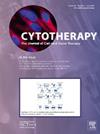Single Extracellular Vesicle Profiling: Harnessing NanoFlow Cytometry for Quantitative Surface Marker Analysis
IF 3.7
3区 医学
Q2 BIOTECHNOLOGY & APPLIED MICROBIOLOGY
引用次数: 0
Abstract
Background & Aim
Heterogeneity of extracellular vesicle (EV) populations complicates their study, as traditional bulk analysis methods fail to capture individual differences in size, content, and surface markers. Single-vesicle analysis offers a more precise approach, enabling detailed characterization of EV subpopulations. In this study, we developed protocols for calibrated NanoFlow cytometry to quantify single-vesicle surface marker expression and applied them to purified MSC-EVs from three different tissue sources.
Methodology
We generated highly purified MSC-EVs through RoosterBio established production and purification protocols. EV tetraspanin identity markers (CD81 and CD63) and MSC identity marker (CD73) were selected for single-vesicle analysis. For each antibody, optimization steps were performed to identify the optimal staining protocol. Beads with known equivalent reference fluorophore (ERF) values were obtained from NanoFCM. Data was acquired on the NanoFCM Flow NanoAnalyzer and single-vesicle analysis methods were established to quantify the number of CD molecules per particle. The lower limit of detection was determined by background fluorescence. We then applied this analysis to purified EVs from bone marrow (BM), umbilical cord (UC), and adipose (AD) MSC-EVs.
Results
Antibody titration was used to select a dilution of 800X for samples at 1 × 1010 P/mL. A standard curve was generated from ERF beads to calibrate arbitrary fluorescence intensity to units of Alexa Fluor™ 488. The antibody-specific limit of detection for positive expression was between 4 – 10 molecules per particle. Across all tissue sources, particles were 50 – 70% CD81+, 40 – 60% CD63+, and 15 – 35% CD73+. Single-vesicle analysis suggested CD81 and CD63 were enriched on AD-EVs (40 CD81, 53 CD63 per particle) compared to UC-EVs (33 CD81, 44 CD63 per particle) and BM-EVs (30 CD81, 41 CD63 per particle). CD73 was preferentially expressed on larger EVs and showed ∼20 CD73 per particle for all tissue sources.
Conclusion
We successfully developed single-vesicle quantitation of EV surface markers by calibrated NanoFlow cytometry. Application of this novel analysis not only showed retention of CD81, CD63, and CD73 in our highly purified EVs, but also discerned tissue- and marker-dependent differences in EV properties. This high-resolution characterization of EVs can advance our understanding of EV diversity, aid interpretation of EV bioactivity, and support development of methods to enrich specific EV subtypes.
单个细胞外囊泡分析:利用纳米流式细胞术进行定量表面标记分析
背景,细胞外囊泡(EV)群体的异质性使他们的研究复杂化,因为传统的批量分析方法无法捕获大小、含量和表面标记物的个体差异。单囊泡分析提供了更精确的方法,能够详细表征EV亚群。在这项研究中,我们开发了校准的NanoFlow细胞术方案来量化单囊泡表面标记物的表达,并将其应用于来自三种不同组织来源的纯化msc - ev。方法:通过RoosterBio建立了高纯度的msc - ev生产和纯化方案。选择EV四跨蛋白身份标记(CD81和CD63)和MSC身份标记(CD73)进行单泡分析。对于每个抗体,进行优化步骤以确定最佳染色方案。从NanoFCM中获得具有已知等效参考荧光团(ERF)值的微珠。在NanoFCM流动纳米分析仪上获取数据,并建立单囊泡分析方法来定量每个颗粒的CD分子数。检测下限由本底荧光测定。然后,我们将该分析应用于从骨髓(BM)、脐带(UC)和脂肪(AD)中纯化的msc - ev。结果抗体滴定法选择样品在1 × 1010 P/mL的稀释度为800X。从ERF珠生成标准曲线,将任意荧光强度校准为Alexa Fluor™488的单位。阳性表达的抗体特异性检测限在4 - 10分子/颗粒之间。在所有组织源中,CD81+颗粒为50 - 70%,CD63+颗粒为40 - 60%,CD73+颗粒为15 - 35%。单囊泡分析表明,ad - ev上的CD81和CD63(每颗粒40 CD81, 53 CD63)比uc - ev(每颗粒33 CD81, 44 CD63)和bmp - ev(每颗粒30 CD81, 41 CD63)富集。CD73优先在较大的ev上表达,在所有组织源中显示每颗粒约20个CD73。结论采用标定的纳米流式细胞术成功地建立了EV表面标记物的单泡定量方法。这项新分析的应用不仅显示了CD81、CD63和CD73在我们高度纯化的EV中的保留,而且还识别了EV特性中组织和标记依赖的差异。这种高分辨率的EV特征可以促进我们对EV多样性的理解,有助于解释EV的生物活性,并支持开发丰富特定EV亚型的方法。
本文章由计算机程序翻译,如有差异,请以英文原文为准。
求助全文
约1分钟内获得全文
求助全文
来源期刊

Cytotherapy
医学-生物工程与应用微生物
CiteScore
6.30
自引率
4.40%
发文量
683
审稿时长
49 days
期刊介绍:
The journal brings readers the latest developments in the fast moving field of cellular therapy in man. This includes cell therapy for cancer, immune disorders, inherited diseases, tissue repair and regenerative medicine. The journal covers the science, translational development and treatment with variety of cell types including hematopoietic stem cells, immune cells (dendritic cells, NK, cells, T cells, antigen presenting cells) mesenchymal stromal cells, adipose cells, nerve, muscle, vascular and endothelial cells, and induced pluripotential stem cells. We also welcome manuscripts on subcellular derivatives such as exosomes. A specific focus is on translational research that brings cell therapy to the clinic. Cytotherapy publishes original papers, reviews, position papers editorials, commentaries and letters to the editor. We welcome "Protocols in Cytotherapy" bringing standard operating procedure for production specific cell types for clinical use within the reach of the readership.
 求助内容:
求助内容: 应助结果提醒方式:
应助结果提醒方式:


